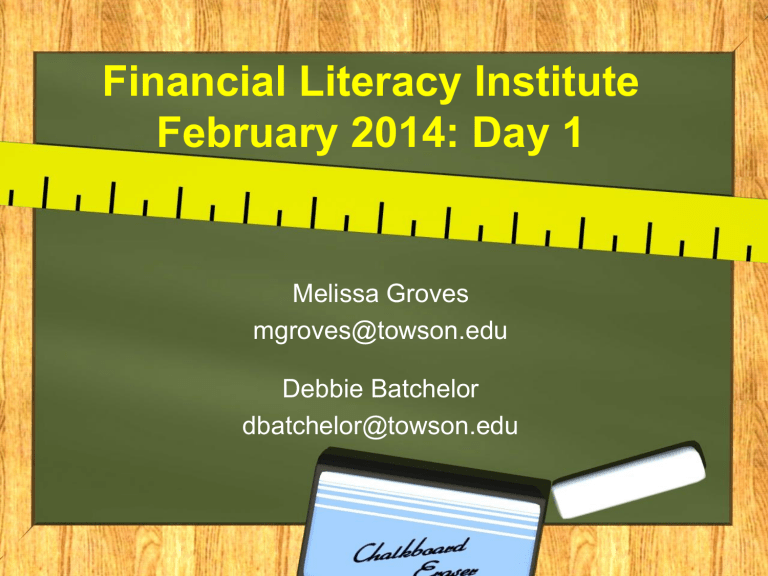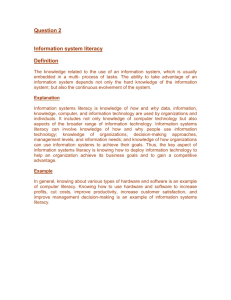Debbie - Towson University

Financial Literacy Institute
February 2014: Day 1
Melissa Groves mgroves@towson.edu
Debbie Batchelor dbatchelor@towson.edu
Our mission is to insure that Maryland's school children leave high school equipped with the economic, financial literacy and decision-making content and skills they need to make informed, rational decisions as consumers, workers, citizens, savers, investors and participants in the global economy.
How Does MCEE
Accomplish Its Mission?
Maintaining the MCEE website at www.econed.org
Sponsoring signature programs
– Stock Market Game
™
– The Poster Contest
Assisting with curriculum writing
Providing Professional Development for educators
Grades
1 MSDE CPD
( plus 1 AU for Baltimore City Teachers)
Active participation
In-Class Quizzes (2)
30%
20%
Online Rdgs/Assessments 25%
Post-Test 20%
Behavioral Survey 5%
Grades
2 MSDE CPD
( plus 1 AU for Baltimore City Teachers)
Active participation
In-Class Quizzes (2)
Online Rdgs/Assessments
Post-Test
20%
20%
20%
20%
Behavioral Survey 5%
Original Lesson; Field Test; Summary 15%
Grading Notes
Original Lesson Plan
(Due on/before 5:00 p.m. March 28, 2014)
– Based on a literary or informational text
– Aligned to one or more of Maryland’s Financial
Literacy Standards AND Reading and/or Mathematics
Common Core
– Using same format as MCEE lessons distributed throughout the Institute
Field Test/Written Summary
(Due on/before 5:00 p.m.
March 28, 2014)
– Teach your original lesson (as outlined above) to your students
– Submit a written summary that includes: student’s response to the lesson, what did/did not work, changes you would make in the future based on the success/failure of the field test
Grading Notes, cont
Behavioral Survey
• Pre-Survey: Completed on Day 1 of the course
• Post-Survey: Completed in late April
- You will receive notification relative to the method of taking the test, i.e. ScanTron,
Survey Monkey, Online testing site, etc….
- Results will remain anonymous
- No credits issued until the Behavioral
Survey is returned in late April/early May
Objectives
During this presentation, we will
…
• explore the Maryland State Curriculum for Personal Financial Literacy
Education
• review key financial literacy concepts for Grades K-5
• link lessons to concepts and standards…including the Common Core
How the Institute Works:
The Ying and Yang of It
Melissa Debbie
Content Pedagogy
Financial Literacy
A variety of materials to help you
Why Financial Literacy ?
Develops financial literacy skills that will enable students to make sound choices as consumers
Helps to establish good habits and responsible attitudes from at an early age
What Personal Finance is About
Your source for understanding aspects of
Financial Literacy
The Maryland State Curriculum for
Personal Financial Literacy Education
1. Defines what students should know and be able to do at various points in time
2. Specific grade-level curriculum to be developed by the individual LEAs
3. Implemented: September
2011
The Standards
1. Making informed responsible decisions
2. Relate careers, education, and income
3. Plan and Manage Money
4. Managing credit and debt
5. Creating and building wealth
6. Managing risks and preserving wealth
Standard 1
Make Informed, Financially Responsible Decisions
Making financial choices (includes resources, decision-making process, opportunity cost)
Explaining philanthropy
Identifying goals
Markets
Productive Resources
NATURAL HUMAN CAPITAL
(Think “Product”)
Human Resources
Workers; The health, strength, talents, education and skills that humans can use to produce goods and services.
Natural Resources
Gifts of nature that can be used to produce goods and services
Capital Resources
Tools; the goods that are manufactured or constructed by people and used to produce other goods and services.
Decision-Making Process
" It's awfully awfully awful when you can't make up your mind!"
Hunches in Bunches by Dr. Seuss
PROBLEM:
CHOICE #1:
Pros(+) Cons (-)
CHOICE #2:
Pros (+) Cons (-)
SOLUTION:
Another Option
And Yet Another
PROBLEM CRITERIA
TOTALS
Where do I want to go for dinner tonight?
CHOICES/OPTIONS/
ALTERNATIVES
Put a plus (+) or minus (-) in each box to indicate whether the choice meets (+) or does not meet (-) the criteria.
Opportunity Cost
The next best choice!
For Decision-Making &
Opportunity Cost
Check Out…
Lesson 4 Lesson 5
Lesson 15
Philanthropy
A personal interest in helping others, especially through gifts to charity
Goods
Things that people make or grow that satisfy economic wants; things desired by consumers and supplied by producers.
Services
Community jobs; Actions (jobs) that people do for each other
Goods & Services
Lesson 2 Lesson 1
Market
Where buyers and sellers exchange resources, goods, and services.
Mama Panya’s Pancakes:
A Village Tale from Kenya
Market
Goods
Services
Standard 2 Highlights
Relate Careers, Education, and Income
Impact of education, interest & skills on income
( What Personal Finance is About pgs.6-8)
Potential sources of income
How income affects spending
Lesson 1
Isabel’s Car Wash
Relationships among education, skills, economic conditions, and income
Sources of income
Goods
Investing
Standard 3 Highlights
Plan and Manage Money
Spending Plans
Financial Services
Develop Age-Appropriate Financial
Goals
Taxation
Contracts
Contracts
Agreement between two or more people to do or not do something
(Add
“ legally binding
” when age-appropriate)
Behavior Contract
Student Name: Vinny Barbarino
Room: 222
Vinnie Barbarino will demonstrate good behaviors each day at school.
Vinnie is expected to follow the teacher's directions the first time she asks him to do something. He is expected to do so promptly and with a good attitude.
Each time that Vinnie does not meet these expectations, he will receive a tally mark for the day on the tracking sheet. These tally marks will determine the rewards and consequences that Vinny receives, as shown below.
Zero = A chance to roll the die after school for one of the rewards listed below
One = Does not get a chance to roll the die that day
Two or more = Loss of recess the next day and/or other consequences as determined by Mr. Kotter
Die Rolls:
1 = One table point for his table
2 = One raffle ticket for monthly class drawing
3 = One piece of candy
4 = Gets to be first in line for the next school day
5 = Gets to help teacher after school that afternoon
6 = Five marbles for the class marble jar
We agree to the terms of this behavior contract as set forth above.
Gabe Kotter
Maria Babarino
Vinnie Barbarino
Drew Plans a Budget
Decision-Making
Spending Plan
Goods/Services
Allowance Day
Coins in my pocket dance around
As I walk about the mall.
Today was payday for my chores
And I am walking tall.
It seems the coins are pleading
In their jingly, jangly voice:
“
Let
’ s buy a toy!
” “
Let
’ s buy some food!
”
How will I make a choice?
Financial Product
Services offered at financial institutions such as CDs, Money Market Accounts,
Savings Accounts, Loans, Mortgages,
Credit Cards, Insurance, etc
…
.
Be a Wise Consumer
Financial Services
CD? Piggy Bank? Savings Account?
Rachel receives $100 for her high school graduation. She plans to buy a television, but it will cost $200. Rachel figures that, with the money she earns at the her summer job, it will take her 4 months to save enough money for the
TV.
CD? Piggy Bank? Savings Account?
Ari adds up all of the money that he receives for his birthday. Happily he finds that he has a total of $100, which is enough money for the bike that he plans to buy next weekend.
CD? Piggy Bank? Savings Account?
Every year for her birthday, Lakesha
’ s grandparents give her $100 to save for her future education. She wants to earn as much interest as she can on her money.
What Are Taxes?
History of taxes
Meaning and purpose of taxes
How taxes affect individuals
Reasons for taxes
A Make-n-Take Moment
Melissa’s Website
Information from today’s session is available on Melissa’s website at: http://pages.towson.edu/mgroves/FinLitInstitute.html
Info for Online Session
Go to: https://university.educatedinvestor.co
m/university/login.xml?for=MDFLI
(Will email you the link to cut/paste onto your browser.)
Username: Your email address
Password: finlit
Online Session
continued…
Must complete the following modules:
– Getting Started with Saving and Investing
– Basics of Personal Finance
– Basics of Investing
– Working with Financial Advisors
Due: February 7, 2014 by 5:00 p.m.
Extra Credit:
– Complete: Investment Risks module
– Submit via email to Melissa
(mgroves@towson.edu): a one page summary with a recommendation about whether it should be added to the Institute and why






